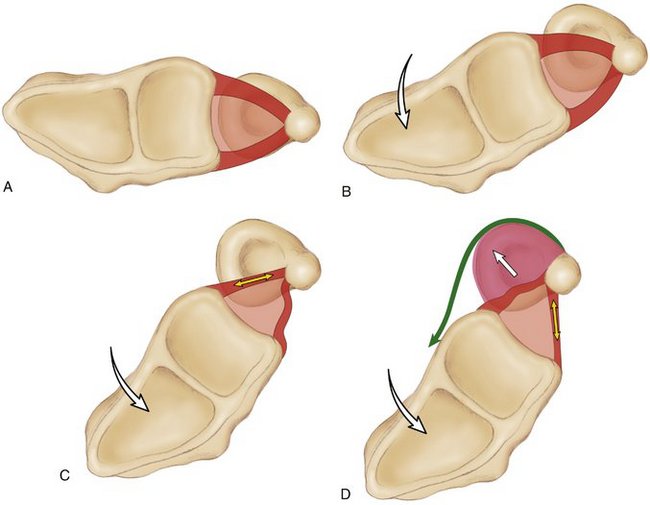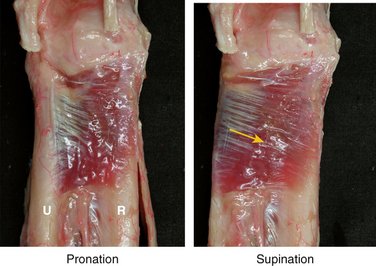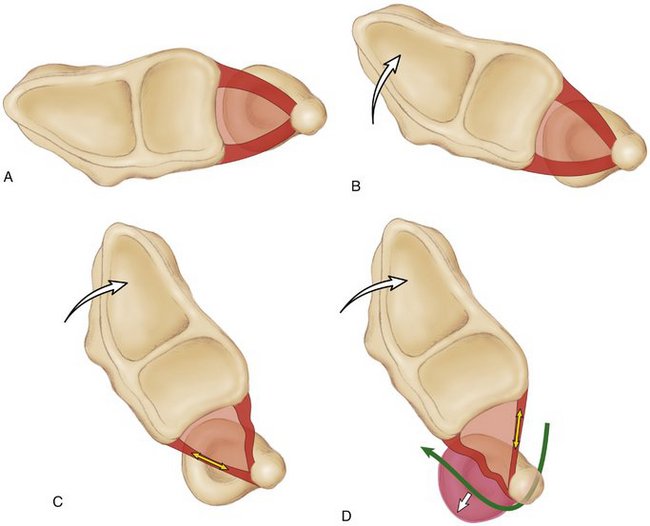CHAPTER 53 Management of Lost Pronosupination
Pronosupination is important in most activities of daily living. A loss of forearm rotation may be compensated by internally or externally rotating the humerus with the elbow semiextended, but this implies a high risk of developing degeneration of the rotator cuff. Without pronosupination, numerous common tasks, such as pouring water from a pitcher into a glass, or fastening a brassiere, are extremely difficult. A forearm with limited pronosupination is a substantial handicap, almost as serious as an unstable distal radioulnar joint (DRUJ).
For a full forearm rotation, not only do proximal and distal radioulnar joints need to be well aligned, with matching lengths and congruent cartilages, but also the soft tissue stabilizing structures must function properly.1–3 Pronosupination is a multifactorial phenomenon that can be affected in many different ways, the more common being distal radius misalignment, radioulnar length discrepancy, joint incongruity, and soft tissue (capsule or muscle or both) contracture.4
Frequently, the loss of supination is secondary to a dorsally malunited distal radial fracture. In such instances, if the triangular fibrocartilage complex (TFCC) has been stretched out or avulsed off the basistyloid fovea, the ulnar head is forced into a dorsally subluxed position relative to the sigmoid notch. Such joint incongruity prevents the normal combination of joint spinning and gliding necessary for a full forearm rotation. Treatment in these cases consists of a radial corrective osteotomy.5
In other circumstances, the ulna may be excessively long as a result of trauma (shortened distal radial fracture) or a congenital defect, and may impinge the lunate during supination and wrist extension, producing pain. Such an abutment may explain a reduced range of forearm rotation. In these cases, any form of ulnar length reduction (i.e., ulnar shortening osteotomy or wafer procedure) is mandatory.6
If the lack of rotation is due to joint incongruity secondary to trauma or cartilage degeneration, many different options exist2: (1) total ulnar head resection,7 (2) “matched ulna” resection,8 (3) hemiresection and fibrous interposition,9 (4) DRUJ fusion plus creation of a metaphyseal pseudarthrosis,10 (5) ulnar head implants,11,12 and (6) total DRUJ prosthesis.13 All of these options are discussed elsewhere in this book, so they are not covered here. This chapter concentrates on the loss of forearm rotation secondary to soft tissue (capsular or muscle or both) contracture.
Pathomechanics
Supination Constraints
As the radius rotates from neutral toward supination, very few changes in ligament tension appear in either the palmar or the dorsal radioulnar ligaments. The horizontal portion of the TFCC, consisting of the articular disc (central zone) and the two peripheral radioulnar ligaments, moves as a unit (Fig. 53-1A and B).3,14 Tension in the palmar radioulnar ligament does not increase until a certain degree of supination is reached (Fig. 53-1C). At this point, the distance between the two ends of the ligament (fovea and palmar corner of the radius) starts increasing until the palmar radioulnar ligament is fully taut, at about 70 degrees of supination.14 If the palmar capsule was not elastic, that would be the limit of supination. The capsule is very lax, however,15 and allows some degree of dorsal subluxation of the radius, with the ulnar head displacing palmarward, decreasing tension in the anterior radioulnar ligament (Fig. 53-1D). This decrease in tension allows further supination up to about 80 degrees, until the dorsal radioulnar ligament becomes fully taut.1
An important dynamic control of the final stages of supination is the pronator quadratus, which in supination becomes stretched and promotes coaptation of the joint, avoiding its subluxation (Fig. 53-2).3,16,17 The palmar radioulnar ligament can be thought of as the primary stabilizer of the early stages of supination,1 whereas the dorsal radioulnar ligament,14 the palmar capsule,15 and the pronator quadratus muscle16,17 are secondary stabilizers avoiding dorsal dislocation of the radius relative to the ulna.
Pronation Constraints
A similar phenomenon occurs during pronation: No substantial changes in tension develop in the two radioulnar ligaments until a certain degree of pronation is achieved (Fig. 53-3A, B). At about 60 degrees of pronation, the dorsal ligament becomes maximally taut (Fig. 53-3C).14 This would stop pronation if it were not for the elastic dorsal capsule, which allows some palmar subluxation of the radius relative to the ulna. As the ulna glides dorsally, there is increasing tensioning of the anterior radioulnar ligament and the dorsal capsule, the two ultimate constraints of pronation (Fig. 53-3D).1
The extensor carpi ulnaris muscle has a similar role to that of the pronator quadratus in that it is an effective dynamic stabilizer of the DRUJ during pronation. As emphasized by Spinner and Kaplan,18 the extensor carpi ulnaris tendon is maintained in a close relationship with the head of the ulna by a fibrous tunnel, independent from the rest of the extensor retinaculum. Because of this, at full pronation, the extensor carpi ulnaris tendon lies medial to the ulnar head and promotes coaptation of this bone against the dorsal rim of the sigmoid cavity, maximizing stability (Fig. 53-4).3,18 The dorsal radioulnar ligament can be thought of as the primary stabilizer of the early stages of pronation,14 whereas the palmar radioulnar ligament,1 the dorsal capsule,15 and the extensor carpi ulnaris muscle18 are secondary stabilizers avoiding palmar dislocation of the radius relative to the ulna.










